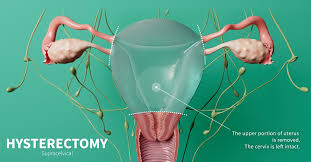Hysterectomy
Understanding Hysterectomy
A hysterectomy is a surgical procedure that involves removing the uterus, and sometimes the cervix and ovaries. It is one of the most commonly performed surgeries in women and is often recommended for various uterine issues such as abnormal bleeding unresponsive to medication, cancer of the uterus, ovaries, or cervix, uterine prolapse, fibroids, and endometriosis.
Why is a Hysterectomy Performed?
A hysterectomy may be necessary for:
- Uterine fibroids (noncancerous tumors of the uterus)
- Endometrial or other gynecological cancers
- Pelvic organ prolapse (when the uterus, bladder, or rectum protrudes outside the vagina)
- Severe endometriosis (abnormal growth of endometrial tissue outside the uterus causing heavy, painful periods)
Types of Hysterectomy
The type of hysterectomy performed depends on the specific condition being treated. The main types include:
- Supracervical Hysterectomy: Removal of the uterus while leaving the cervix intact, typically used for benign conditions like abnormal bleeding or fibroids.
- Total Hysterectomy: Removal of the uterus and cervix, often including parts of surrounding structures. This is the most common type of hysterectomy.
- Radical Hysterectomy: Extensive surgery involving the removal of the uterus, cervix, fallopian tubes, ovaries, and surrounding tissues, usually performed to treat gynecological cancers.
Surgical Techniques for Hysterectomy

Hysterectomies can be performed using different surgical techniques:
- Total Abdominal Hysterectomy (TAH): The uterus is removed through an incision in the abdomen. This method is preferred when the uterus is large or adhered to other organs, or in cases of ovarian cancer.
- Total Laparoscopic Hysterectomy (TLH): The uterus is removed through small incisions using laparoscopic tools. This method allows for quicker recovery and is suitable for treating benign conditions and certain cancers.
- Laparoscopic Assisted Vaginal Hysterectomy (LAVH): Combines laparoscopic and vaginal approaches to remove the uterus.
- Total Vaginal Hysterectomy (TVH): The uterus is removed through the vagina, often due to prolapse. This method is also used for fibroids, endometriosis, or other benign conditions.
- Non-Descent Vaginal Hysterectomy (NDVH): The uterus is removed vaginally without it being prolapsed.
Post-Hysterectomy Care
After a hysterectomy, it is important to follow your doctor's personalized instructions for recovery. Generally, patients can resume basic activities such as light chores and walking within 2-3 days. However, they should avoid heavy lifting and strenuous exercise for several months. Full recovery can take up to six weeks for an abdominal hysterectomy and about two weeks for laparoscopic or vaginal approaches. Returning to work or school should only be done when fully healed. Maintaining a healthy lifestyle and adhering to the doctor’s recommendations is crucial for a smooth recovery.


